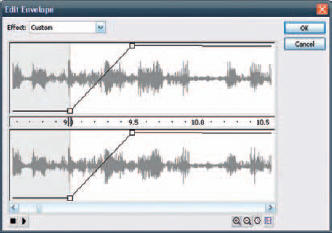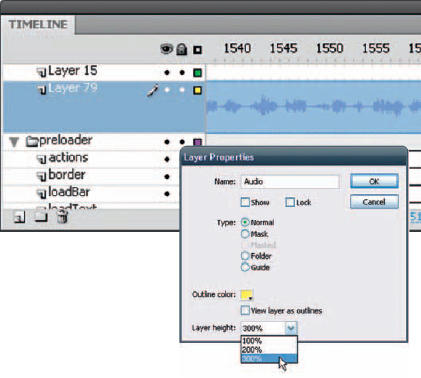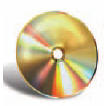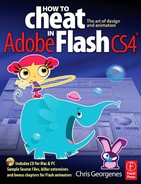THE EDIT ENVELOPE WINDOW offers some limited sound editing features without having to leave the Flash environment. There’s enough features here to control the starting and ending points of your sound file, as well as some basic fading effects. But don’t expect much more beyond that.
As much as Flash could use a few more bells and whistles in this area, it was never meant to be a sound editing program in the first place. Let’s leave that for the dedicated sound editing applications and use Flash for what it is. We can’t expect Flash to do everything can we?

1 Select frame 1 in your Flash document and then go to File > Import > Import to Stage and select your WAV or AIF file. Your sound will be in frame 1 but you will need to insert enough frames to accommodate its length. By default, the sound will be set to Event. Use the drop-down to change the sound’s behavior.
Event: This is used to play a sound at a particular point in time, but independently of other sounds. An Event sound will play in its entirety even if the movie stops. An Event sound must be fully downloaded before it will play.
Start: The same as Event, except that if the sound is already playing, no new instance of the sound plays.
Stop: This stops the selected sound.
Stream: This is used to synchronize a sound with the timeline and, subsequently, the animation. Streaming sounds will start and stop with the playhead.

2 Click the Edit button in the Properties panel to open the Edit Envelope window. Here you will see the waveform of your sound file and a few basic control features. The Effect drop-down menu offers some convenient effects to add to your sound.
Left Channel/Right Channel: Plays sound in the left or right channel only.
Fade Left to Right/Fade Right to Left: Shifts the sound from one channel to the other.
Fade In/Fade Out: Gradually increases/decreases the volume of a sound over its duration.
Custom: Lets you create custom in and out points of sound using the Edit Envelope.

3 You can add up to eight envelope handles by clicking anywhere within the sound window. Each handle can be dragged around to control the volume of the sound at that point in the sound file. The higher the handle is positioned, the louder the sound. To remove a handle, drag it out of the window. To change the sound envelope, drag the envelope handles to change levels at different points in the sound. Envelope lines show the volume of the sound as it plays.

4 To change the start and end points of a sound, drag the Time In and Time Out controls in the Edit Envelope. The tricky thing about this is, without the ability to scrub the waveform in the envelope window, it’s a game of hit or miss (mostly miss). If you need to continue a long sound file across multiple Scenes, you will have to add a new instance of the sound to each Scene. Next, determine where the sound ended in the previous Scene and manually adjust the Time In controller for the current Scene so that the sound starts where the previous Scene ended. It’s not an exact science and not an ideal solution if your audio file is one continuous sound (such as a musical score).

5 In some situations, having the ability to view the waveform is helpful. For example, having a clear visual indicator of when sounds start and stop can help speed up this tedious process. Right-click over the layer name containing your sound and select Properties from the context menu. In the Layer Properties panel, locate the Layer Height drop-down menu and select 300% to increase the height of the layer to its maximum.

6 Many people have experienced a serious issue with sounds, even when set to “stream”, falling out of sync with the animation in the Flash player. The only solution I have found for this is to change the default MP3 compression in the document’s Publish Settings panel. Go to File > Publish Settings and click on the Flash tab. The default MP3 compression is 16 kbps, Mono. Click the “Set...” button next to the “Audio stream...” and change the bit rate to 20 kbps or higher. I personally recommend 24 kbps as the minimum compression setting. Click “OK” and test your movie. Your sync issue should now be resolved.

Hot Tip
Once the sound has been set to Stream behavior, you can then drag the play-head across the timeline to hear your soundtrack. The default Event setting sends the sound to your system’s sound card and forgets about it. It is no longer part of the timeline and will not maintain sync with any animation. The only way to stop an Event sound from playing while in the Flash authoring environment is to hit the Esc key. Event sounds are typically used with shorter sounds and attached to buttons.
![]()
